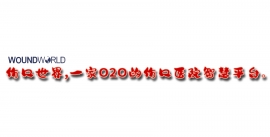
伤口世界

- 星期二, 21 3月 2023
A prospective, randomized assessment of a novel, local antibiotic releasing platform for the prevention of superfcial and deep surgical site infections
O.Zmora1 · Y. Stark2 · O. Belotserkovsky2 · M. Reichert2 · G. A. Kozloski2 · N. Wasserberg3 · H. Tulchinsky4 · L. Segev5 · A.J. Senagore2 · N. Emanuel2
Received: 11 May 2022 / Accepted: 16 August 2022 / Published online: 1 September 2022
© The Author(s) 2022
A. J. Senagore
该Email地址已收到反垃圾邮件插件保护。要显示它您需要在浏览器中启用JavaScript。
1 Shamir Medical Center, Be’er Ya’akov, Israel
2 PolyPid Ltd, Petach Tikvah, Israel
3 Rabin Medical Center, Beilinson Campus, Petach Tikva,
Israel
4 Tel-Aviv Sourasky Medical Center, Tel Aviv, Israel
5 Sheba Medical Center, Tel-Hashomer, Ramat Gan, Israel
Abstract
Background Despite significant advances in infection control guidelines and practices, surgical site infections (SSIs) remain a substantial cause of morbidity, prolonged hospitalization, and mortality among patients having both elective and emergent surgeries. D-PLEX100 is a novel, antibiotic-eluting polymer–lipid matrix that supplies a high, local concentration of doxycycline for the prevention of superficial and deep SSIs. The aim of our study was to evaluate the safety and efficacy of D-PLEX in addition to standard of care (SOC) in preventing superficial and deep surgical site infections for patients undergoing elective colorectal surgery.
Methods From October 10, 2018 to October 6, 2019, as part of a Phase 2 clinical trial, we randomly assigned 202 patients who had scheduled elective colorectal surgery to receive either standard of care SSI prophylaxis or D-PLEX100 in addition to standard of care. The primary objective was to assess the efficacy of D-PLEX100 in superficial and deep SSI reduction, as measured by the incidence of SSIs within 30 days, as adjudicated by both an individual assessor and a three-person endpoint adjudication committee, all of whom were blinded to study-group assignments. Safety was assessed by the stratification and incidence of treatment-emergent adverse events.
Results One hundred and seventy-nine patients were evaluated in the per protocol population, 88 in the intervention arm [51 males, 37 females, median age (64.0 range: 19–92) years] and 91 in the control arm [57 males, 34 females, median age 64.5 (range: 21–88) years]. The SSI rate within 30 day post-index surgery revealed a 64% relative risk reduction in SSI rate in the D-PLEX100 plus standard of care (SOC) group [n=7/88 (8%)] vs SOC alone [n=20/91 (22%)]; p=0.0115. There was no significant difference in treatment-emergent adverse events.
Conclusions D-PLEX100 application leads to a statistically significant reduction in superficial and deep surgical site infections in this colorectal clinical model without any associated increase in adverse events.
Keywords Surgical site infection · Localized antibiotic therapy · Doxycycline

- 星期一, 20 3月 2023
Optimisation of perioperative procedural factors to reduce the risk of surgical site infection in patients undergoing surgery: a systematic review
P.Calò1 · F. Catena2 · D. Corsaro3 · L. Costantini4 · F. Falez5 · B. Moretti6 · V. Parrinello7 · E. Romanini8,9 · A. Spinarelli10 · G. Vaccaro11,12· F. Venneri13
Received: 27 December 2022 / Accepted: 26 January 2023
Published online:13 February 2023
© The Author(s) 2023 OPEN
G. Vaccaro, 该Email地址已收到反垃圾邮件插件保护。要显示它您需要在浏览器中启用JavaScript。 | 1 University Teaching Hospital of Cagliari and Surgical Department at University of Cagliari, Cagliari, Italy. 2 Department General and Emergency Surgery at Bufalini Hospital, Cesena, Italy. 3 International Research at BHAVE, Via GiambattistaVico 1, 00196 Rome, Italy. 4 Department of Medical and Surgical Sciences, School of Community Medicine and Primary Care, University of Modena and Reggio Emilia, Modena, Italy. 5 Department of Orthopaedics ASL Roma 1 and Director UOC Orthopaedics Hospital San Filippo Neri, Rome, Italy. 6 Orthopedics and Traumatology Complex Operative Unit, University Teaching Hospital of Bari Polyclinic, Bari, Italy. 7 Operative Unit of Quality and Clinical Risk Manager at “G.Rodolico-San Marco” University Teaching Hospital in Catania, Catania, Italy. 8 SIOT Guidelines Commission, Rome, Italy. 9 Complex Operative Unit of Orthopedics and Traumatology at University Teaching Hospital of Bari Polyclinic, Bari, Italy. 10Operative Unit of Orthopedics and Traumatology at University Teaching Hospital of Bari Polyclinic, Bari, Italy. 11Social, Epidemiological and Outcome Research at BHAVE, Via Giambattista Vico 1, 00196 Rome, Italy. 12Sociologist UO Education and Health Promotion, Asp Catania, Via Santa Maria la Grande 5, 95124 Catania, Italy. 13Simple Structure Clinical Risk and Surgical Emergency in Florence, Florence, Italy.
Abstract
Surgical site infections (SSI) are the leading cause of hospital readmission after surgical procedures with significant impact on post-operative morbidity and mortality. Modifiable risk factors for SSI include procedural aspects, which include the possibility of instrument contamination, the duration of the operation, the number of people present and the traffic in the room and the ventilation system of the operating theatre.The aim of this systematic review was to provide literature evidence on the relationship between features of surgical procedure sets and the frequency of SSI in patients undergoing surgical treatment, and to analyse how time frames of perioperative processes and operating theatre traffic vary in relation to the features of the procedure sets use, in order tooptimise infection control in OT. The results of the systematic review brought to light observational studies that can be divided into two categories: evidence of purely clinical significance and evidence of mainly organisational, managerial and financial significance. These two systems are largely interconnected, and reciprocally influence each other. The decision to use disposable devices and instruments has been accompanied by a lower incidence in surgical site infections and surgical revisions for remediation. A concomitant reduction in post-operative functional recovery time has also been observed. Also, the rationalisation of traditional surgical sets has also been observed in conjunction with outcomes of clinical significance.

- 星期一, 20 3月 2023
Global variation in skin injures and skincare practices in extremely preterm infants
Pranav Jani1,2 · Umesh Mishra1,2 · Julia Buchmayer3 · Rajesh Maheshwari1,2 · Daphne D’Çruz2 · Karen Walker1,4,5,6,7 · Duygu Gözen8 · Krista Lowe2 · Audrey Wright2 · James Marceau2 · Mihaela Culcer1,2 · Archana Priyadarshi1,2 · Adrienne Kirby9 · James E. Moore10,11 · Ju Lee Oei12,13 · Vibhuti Shah14 · Umesh Vaidya15 · Abdelmoneim Khashana16 · Sunit Godambe17 · Fook Choe Cheah18,19 · Wen‑Hao Zhou20 · Xiao‑Jing Hu21 · Muneerah Satardien22,23
Received: 28 July 2022 / Accepted: 19 September 2022 / Published online: 13 November 2022 © The Author(s) 2022
Abstract
Background Globally, are skincare practices and skin injuries in extremely preterm infants comparable? This study describes skin injuries, variation in skincare practices and investigates any association between them.
Methods A web-based survey was conducted between February 2019 and August 2021. Quantifying skin injuries and describing skincare practices in extremely preterm infants were the main outcomes. The association between skin injuries and skincare practices was established using binary multivariable logistic regression adjusted for regions.
Results Responses from 848 neonatal intensive care units, representing all geographic regions and income status groups were received. Diaper dermatitis (331/840, 39%) and medical adhesive-related skin injuries (319/838, 38%) were the most common injuries. Following a local skincare guideline reduced skin injuries [medical adhesive-related injuries: adjusted odds ratios (aOR)=0.63, 95% confidence interval (CI)=0.45–0.88; perineal injuries: aOR=0.66, 95% CI=0.45–0.96; local skin infections: OR=0.41, 95% CI=0.26–0.65; chemical burns: OR=0.46, 95% CI=0.26–0.83; thermal burns: OR=0.51, 95% CI=0.27–0.96]. Performing skin assessments at least every four hours reduced skin injuries (abrasion: aOR=0.48, 95% CI=0.33–0.67; pressure: aOR=0.51, 95% CI=0.34–0.78; diaper dermatitis: aOR=0.71, 95% CI=0.51–0.99; perineal: aOR=0.52, 95% CI=0.36–0.75). Regional and resource settings-based variations in skin injuries and skincare practices were observed.
Conclusions Skin injuries were common in extremely preterm infants. Consistency in practice and improved surveillance appears to reduce the occurrence of these injuries. Better evidence regarding optimal practices is needed to reduce skin injuries and minimize practice variations.
Keywords Extremely premature infants · Injuries · Neonatal intensive care unit · Skin care · Wounds
Pranav Jani
该Email地址已收到反垃圾邮件插件保护。要显示它您需要在浏览器中启用JavaScript。
Extended author information available on the last page of the article

- 星期二, 14 3月 2023
Evaluation of an infection control link nurse program: an analysis using the RE-AIM framework
Mireille Dekker1*, Irene P. Jongerden2 , Martine G. Caris1 , Martine C. de Bruijne2 , Christina M. J. E. Vandenbroucke‑Grauls1,3 and Rosa van Mansfeld1
*Correspondence:
Mireille Dekker
该Email地址已收到反垃圾邮件插件保护。要显示它您需要在浏览器中启用JavaScript。
1 Department of Medical Microbiology and Infection Prevention, Amsterdam UMC, Vrije Universiteit Amsterdam, De Boelelaan 1118, 1081 HV Amsterdam, The Netherlands
2 Department of Public and Occupational Health, Amsterdam UMC, Vrije Universiteit Amsterdam, Amsterdam Public Health Research Institute, Amsterdam, The Netherlands
3 Department of Clinical Medicine – Department of Clinical Epidemiology, Aarhus University, Aarhus, Denmark
© The Author(s) 2023. Open Access This article is licensed under a Creative Commons Attribution 4.0 International License, which permits use, sharing, adaptation, distribution and reproduction in any medium or format, as long as you give appropriate credit to the original author(s) and the source, provide a link to the Creative Commons licence, and indicate if changes were made. The images or other third party material in this article are included in the article’s Creative Commons licence, unless indicated otherwise in a credit line to the material. If material is not included in the article’s Creative Commons licence and your intended use is not permitted by statutory regulation or exceeds the permitted use, you will need to obtain permission directly from the copyright holder. To view a copy of this licence, visit http://creativecommons.org/licenses/by/4.0/. The Creative Commons Public Domain Dedication waiver (http://creativeco mmons.org/publicdomain/zero/1.0/) applies to the data made available in this article, unless otherwise stated in a credit line to the data.
Abstract
Background Important elements of programs that train and support infection control link nurses (ICLN) are the engagement of stakeholders, support from hospital and ward management and a structure for iterative improvement. The effects of programs, that combine all these elements, are unknown. We evaluated such a comprehensive program to explore its impact on link nurses and infection prevention practices and routines.
Methods We used the RE-AIM framework, a robust, evidence-based framework within the field of Implementation Science, to evaluate the impact of our ICLN training and support program. We used a mixed methods approach and organized the outcomes along its five dimensions: Reach, Effectiveness, Adoption, Implementation and Maintenance.
Results Between 2014 and 2018, on average 91% of the inpatient wards and 58% of the outpatient clinics participated in the program (Reach) and impacted guideline adherence in inpatient wards. Link nurses felt engaged and empowered, and perceived their contribution to these results as pivotal. Ward managers confirmed the value of ICLN to help with implementing IPC practices (Effectiveness). The program was adopted both at the hospital and at the ward level (Adoption). Based on ongoing evaluations, the program was adapted by refining education, training and support strategies with emphasis on ward specific aspects (Implementation). The ICLN program was described as a key component of the infection prevention policy to sustain its effects (Maintenance).
Conclusions Our infection control link nurse program helped ICLN to improve infection prevention practices, especially in inpatient wards. The key to these improvements lay within the adaptability of our link nurse program. The adjustments to the program led to a shift of focus from hospital goals to goals tailored to the ward level. It allowed us to tailor activities to align them with the needs specific to each ward.
Keywords Quality improvement, Patient safety, Nursing practice, Nosocomial infections, Infection prevention

- 星期一, 13 3月 2023
Empagliflozin protects mice against diet-induced obesity, insulin resistance and hepatic steatosis
Bernhard Radlinger1,2 & Claudia Ress1,2 & Sabrina Folie1,2 & Karin Salzmann1,2 & Ana Lechuga1,2 & Bernhard Weiss 1,2,3 & Willi Salvenmoser4 & Michael Graber5 & Jakob Hirsch5 & Johannes Holfeld5 & Christian Kremser6 & Patrizia Moser3 & Gabriele Staudacher1,2 & Tomas Jelenik7 & Michael Roden7,8,9 & Herbert Tilg2 & Susanne Kaser1,2
Susanne Kaser
该Email地址已收到反垃圾邮件插件保护。要显示它您需要在浏览器中启用JavaScript。
1 Christian Doppler Laboratory for Metabolic Crosstalk, Medical University Innsbruck, Innsbruck, Austria
2 Department of Internal Medicine I, Medical University Innsbruck, Innsbruck, Austria
3 Innpath GmbH, Innsbruck, Austria
4 Institute of Zoology and Center of Molecular Biosciences Innsbruck (CBMI), Leopold Franzens University Innsbruck, Innsbruck, Austria
5 Department of Cardiac Surgery, Medical University Innsbruck, Innsbruck, Austria
6 Department of Radiology, Medical University Innsbruck, Innsbruck, Austria
7 Institute for Clinical Diabetology, German Diabetes Center, Leibniz Center for Diabetes Research at Heinrich-Heine-University Düsseldorf, Düsseldorf, Germany
8 Department of Endocrinology and Diabetology, Medical Faculty and University Hospital Düsseldorf, Heinrich-Heine-University Düsseldorf, Düsseldorf, Germany
9 German Center for Diabetes Research, Partner Düsseldorf, München-Neuherberg, Germany
Received: 5 September 2022 /Accepted: 31 October 2022 / Published online: 16 December 2022 © The Author(s) 2022
Abstract Aims/hypothesis Sodium–glucose cotransporter 2 (SGLT2) inhibitors are widely used in the treatment of type 2 diabetes, heart failure and chronic kidney disease. Their role in the prevention of diet-induced metabolic deteriorations, such as obesity, insulin resistance and fatty liver disease, has not been defined yet. In this study we set out to test whether empagliflozin prevents weight gain and metabolic dysfunction in a mouse model of diet-induced obesity and insulin resistance.
Methods C57Bl/6 mice were fed a western-type diet supplemented with empagliflozin (WDE) or without empagliflozin (WD) for 10 weeks. A standard control diet (CD) without or with empagliflozin (CDE) was used to control for diet-specific effects.
Metabolic phenotyping included assessment of body weight, food and water intake, body composition, hepatic energy metabolism, skeletal muscle mitochondria and measurement of insulin sensitivity using hyperinsulinaemic–euglycaemic clamps.
Results Mice fed the WD were overweight, hyperglycaemic, hyperinsulinaemic and insulin resistant after 10 weeks. Supplementation of the WD with empagliflozin prevented these metabolic alterations. While water intake was significantly increased by empagliflozin supplementation, food intake was similar in WDE- and WD-fed mice. Adipose tissue depots measured by MRI were significantly smaller in WDE-fed mice than in WD-fed mice. Additionally, empagliflozin supplementation prevented significant steatosis found in WD-fed mice. Accordingly, hepatic insulin signalling was deteriorated in WD-fed mice but not in WDE-fed mice. Empagliflozin supplementation positively affected size and morphology of mitochondria in skeletal muscle in both CD- and WD-fed mice.
Conclusions/interpretation Empagliflozin protects mice from diet-induced weight gain, insulin resistance and hepatic steatosis in a preventative setting and improves muscle mitochondrial morphology independent of the type of diet.
Keywords Empagliflozin . Insulin resistance . Obesity . SGLT2 inhibition . Skeletal muscle mitochondria . Steatosis . Western-type diet

- 星期五, 10 3月 2023
Do sex differences in paediatric type 1 diabetes care exist? A systematic review
Silvia A. G. de Vries1 iD Carianne L. Verheugt1 iD Dick Mul2 iD Max Nieuwdorp1 iD Theo C. J. Sas2,3
Received: 26 April 2022 /Accepted: 25 November 2022
© The Author(s) 2023
Abstract
Aims/hypothesis Sex differences are present in cardiovascular care and in outcomes among adults with type 1 diabetes mellitus, which typically commences in childhood. Whether sex influences care and outcomes in childhood is not known. This systematic review provides an overview of sex differences in children with type 1 diabetes, focusing on patient and disease characteristics, treatment, comorbidities and complications.
Methods Literature in MEDLINE up to 15 June 2021 was searched, using the terms diabetes mellitus, sex characteristics, sex distribution, children and/or adolescents. All primary outcome studies on children with type 1 diabetes that mentioned a sex difference in outcome were included, with the exception of qualitative studies, case reports or case series. Studies not pertaining to the regular clinical care process and on incidence or prevalence only were excluded. Articles reporting sex differences were identified and assessed on quality and risk of bias using Joanna Briggs Institute critical appraisal tools. Narrative synthesis and an adapted Harvest plot were used to summarise evidence by category.
Results A total of 8640 articles were identified, rendering 90 studies for review (n=643,217 individuals). Studies were of observational design and comprised cohort, cross-sectional and case–control studies. Most of the included studies showed a higher HbA1c in young female children both at diagnosis (seven studies, n=22,089) and during treatment (20 out of 21 studies, n=144,613), as well as a steeper HbA1c increase over time. Many studies observed a higher BMI (all ages, ten studies, n=89,700; adolescence, seven studies, n=33,153), a higher prevalence of being overweight or obese, and a higher prevalence of dyslipidaemia among the female sex. Hypoglycaemia and partial remission occurred more often in male participants, and ketoacidosis (at diagnosis, eight studies, n=3561) and hospitalisation was more often seen in female participants. Most of the findings showed that female participants used pump therapy more frequently (six studies, n=211,324) and needed higher insulin doses than male participants. Several comorbidities, such as thyroid disease and coeliac disease, appeared to be more common in female participants. All studies reported lower quality of life in female participants (15 studies, n=8722). Because the aim of this study was to identify sex differences, studies with neutral outcomes or minor differences may have been under-targeted. The observational designs of the included studies also limit conclusions on the causality between sex and clinical outcomes.
Conclusions/interpretation Sex disparities were observed throughout diabetes care in children with type 1 diabetes. Several outcomes appear worse in young female children, especially during adolescence. Focus on the cause and treatment of these differences may provide opportunities for better outcomes.
Registration This systematic review is registered in PROSPERO (CRD42020213640)
Keywords Child . Diabetes mellitus . Narrative synthesis . Sex differences . Systematic review . Type 1 diabetes
* Silvia A. G. de Vries
该Email地址已收到反垃圾邮件插件保护。要显示它您需要在浏览器中启用JavaScript。
1 Department of Vascular Medicine, Amsterdam University Medical Centers, Amsterdam, the Netherlands
2 Diabeter, Center for Paediatric and Adult Diabetes Care and Research, Rotterdam, the Netherlands
3 Department of Paediatrics, Division of Paediatric Endocrinology, Erasmus University Medical Center, Sophia Children’s Hospital, Rotterdam, the Netherlands
https://doi.org/10.1007/s00125-022-05866-4
/ Published online: 26 January 2023
